Introduction: Blockchain Technology
 Ali Raza
Ali RazaTable of contents
- What is Blockchain?
- Fundamentals of Blockchain
- Peer-to-Peer Network
- Hashing
- Decentralization
- Byzantine Generals' Problem
- Consensus Algorithms
- Blind Signatures
- Proof of Work
- Proof of Stake
- Distributed Ledger Technology
- Blockchain Classification
- How Blockchain Works
- Applications of Blockchain
- Future Scope of Blockchain Technology

Blockchain technology is a game-changer for many industries, including finance, healthcare, and even voting systems. But what exactly is it?
In layman's terms, a blockchain is a digital ledger of transactions that is spread across a network of computers. This network is connected through cryptography, making it virtually tamper-proof. Each block in the chain contains information about multiple transactions, and once a block is added to the chain, its information is permanent and cannot be altered. One of the biggest benefits of using blockchain technology is that it eliminates the need for intermediaries, such as banks, in transactions. This not only saves time but also reduces the risk of fraud and increases transparency. Think of it like a digital notebook where multiple people can write and read entries, but no one can erase or manipulate them. This is what makes blockchain technology so secure and trustworthy.
So why is this technology so important and why are so many industries excited about it? Simply put, it has the potential to streamline processes, increase efficiency, and promote transparency, all while reducing the risk of fraud.
It was introduced to the world with the creation of Bitcoin in 2008. It has the potential to revolutionize all industries, including finance, government, media, law, and arts. Some view it as a revolution while others see it as an evolution, but the revolution has already begun. Prominent organizations around the world are experimenting with blockchain and its disruptive potential is being fully recognized. The Australian Securities Exchange (ASX) is set to become the first organization to replace its legacy system with blockchain technology. In 2019, more research is expected to be conducted, leading to production-ready projects and products utilizing blockchain technology by 2020. By 2025, blockchain is expected to become mature enough for everyday use. Interest in blockchain has risen significantly in recent years, with millions of dollars being invested by companies and organizations worldwide. The European Union has announced plans to increase funding for blockchain research to 340 million euros by 2020. Consortiums such as Enterprise Ethereum Alliance, Hyperledger, and R3 have been established for research and development, and many start-ups are already providing blockchain-based solutions. The benefits of blockchain include decentralized trust, cost savings, transparency, and efficiency, while challenges such as scalability and privacy remain areas of active research.
What is Blockchain?
Definition of Blockchain: A secure, shared, ever-growing system for record-keeping in which each user holds a copy of the records that can only be updated with agreement from all parties involved in a transaction.
Peer-to-Peer: No central controller, all participants directly communicate with each other, allowing for direct transactions without the need for third-party involvement.
Distributed Ledger: The ledger is spread across the network and each participant holds a complete copy.
Cryptographically secure: Cryptography provides security against tampering and misuse, including non-repudiation, data integrity, and data origin authentication.
Append-only: Data can only be added in time-ordered sequential order, making it almost impossible to change once added and considered practically immutable.
Updateable via Consensus: The most critical attribute, the ledger can only be updated via consensus, giving it the power of decentralization and ensuring agreement among all participating peers/nodes.
Consensus Algorithms: Various algorithms are used to facilitate consensus and agree upon the final state of data on the network.
What problem does it solve?
Blockchain technology is all about solving the problem of trust. It allows people to transact with each other, even if they don't fully trust each other, without the need for a trusted middleman.
Traditionally, we rely on central trusted parties, like banks, to conduct business, but with blockchain, we don't need to. This changes the way we do business and brings about many benefits such as lower costs, increased security, and greater transparency.
We'll talk about the Byzantine Generals' Problem, a key concept in understanding how blockchain solves trust issues, later in this blog.
Advantages of Blockchain
Decentralization: Transactions are validated through a consensus mechanism, eliminating the need for a trusted third party.
Transparency and Trust: The shared, public ledger leads to transparency and establishes trust in the system.
Immutability: Changing the data on the blockchain is difficult, leading to a secure, permanent ledger of transactions.
High Availability: The peer-to-peer network and data replication ensure that the system remains available, even if some nodes leave the network.
High Security: All transactions are secured with cryptography, maintaining network integrity.
Simplified Processes: A single shared ledger among multiple entities simplifies the current, disorganized paradigms in industries like finance and health.
Faster Dealings: Quicker settlement of trades in the financial industry.
Cost Saving: No need for a trusted third party or clearing house reduces overhead costs.
Fundamentals of Blockchain
Blockchain is a powerful technology that has several important features. Here are a few of them:
Distributed Consensus: This is the foundation of blockchain technology. It means that all participants in the network agree on the same version of the truth, without the need for a central authority.
Transaction Verification: Every transaction made on the blockchain is verified using a set of rules. Only valid transactions are included in a block.
Platform for Smart Contracts: A blockchain can be used as a platform for running smart contracts, which are automated programs that can execute business logic for users. Not all blockchains have this feature, but newer platforms like Ethereum and MultiChain do.
Smart Contracts: The blockchain provides a platform for running smart contracts, which are automated, self-executing programs that enforce business logic and conditions. For example, an insurance contract can be made into a smart contract so that as soon as the flight is canceled, the payment is automatically made to the traveler. This saves time, increases trust, and reduces costs compared to traditional methods. Smart contracts can be programmed to meet the specific needs of businesses and their requirements. With blockchain, we can create a more flexible, secure, and efficient system.
Transferring value between peers: With blockchain technology, you can easily transfer value between users using tokens. These tokens act like digital currency and can be used to store and exchange value. Some blockchain systems also allow for the creation of their own cryptocurrency as a reward for users who validate transactions and help to keep the network secure. This feature may not be available in all types of blockchains.
Smart Property: Have you ever heard of "double-spending"? It's when someone tries to spend the same digital asset twice, and it can be a major issue in digital transactions. That's why blockchain technology is so revolutionary. It allows you to link your digital or physical assets to the blockchain in a way that makes it almost impossible for anyone else to claim them.
Think about it like this: have you ever tried to download a digital music file and found that it's easily copied and shared all over the internet? That's because there are no controls in place to prevent that from happening. But with blockchain, you have full control over your assets and they can't be double-spent or double-owned.
There are Digital Rights Management (DRM) systems in place to protect copyrights, but they're not always enforceable. For example, there have been cases where DRM systems were hacked and people were able to access the content for free. With blockchain, DRM can be fully enforced and protect your assets from theft.
For example, if you own an asset on the blockchain, no one else can claim it unless you decide to transfer it. This is a game-changer for the DRM and electronic cash systems, where double-spend detection is crucial. The double-spend problem was first solved without the need for a trusted third party in Bitcoin, making blockchain technology even more valuable.
Provider of Security: The blockchain uses strong cryptography to keep your data secure and available. However, this technology doesn't always protect the privacy of transactions, which can be a barrier for some businesses and organizations. To address this, researchers are working on ways to improve privacy on the blockchain. In some cases, like with Bitcoin, privacy is not essential but still desirable. Other cryptocurrencies, like Zcash, offer more anonymous transactions.
The blockchain also offers security features like preventing fake transactions and verifying users with private keys and digital signatures. These features ensure the safety of all actions on the blockchain.
Immutability: Once information is added to the blockchain, it's permanent and can't be changed easily. This is a big advantage of the blockchain, as it ensures the records are trustworthy and can't be altered. If someone tries to change information that's already on the blockchain, it would take a huge amount of computing power, making it almost impossible. For example, in Bitcoin, changing previous blocks would require redoing all the work that was done to add those blocks to the blockchain in the first place. This makes the information on the blockchain immutable, giving users confidence in the security and reliability of the system.
Uniqueness: One of the important aspects of blockchain technology is that it prevents the same digital asset from being spent twice. This is especially important when it comes to cryptocurrencies, where making sure a coin or token isn't being spent twice is a critical part of keeping the system secure and trustworthy. With blockchain, every transaction is unique and can be easily verified to ensure that it hasn't already been spent, making it an effective solution to the double-spend problem.
What is a Block?
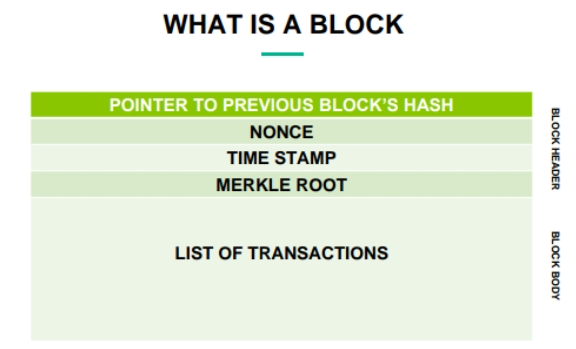
A block is a selection of transactions bundled together and organized logically. A block is made up of transactions, and its size varies depending on the type and design of the blockchain in use. It typically contains
Pointer to the previous block’s hash
Nonce
Timestamp
Merkle root
List of transactions
What is a Transaction?
A transaction is simply a record of an event. In terms of cryptocurrency, a transaction means moving money from one account to another. In more advanced blockchain systems like Ethereum, Bitcoin, etc., a transaction can also refer to activating a smart contract. Basically, any time something changes on the blockchain, it's considered a transaction.
Structure of a Blockchain

A blockchain is a chain of blocks that hold records of transactions. Each block is linked to the one before it using a unique code called a "hash." The first block called the "genesis block," doesn't need a previous hash because it was the first block created when the blockchain started.
Elements of Blockchain
Blockchain is a complex technology made up of several elements. Understanding these elements will help you have a better understanding of how blockchain works. Here's a breakdown of the key elements of a generic blockchain:
Address: Addresses are special codes used to identify the sender and recipient of a transaction. They are usually based on a public key and are unique. To maintain privacy, it's a good practice to generate a new address for each transaction.
Transaction: This is the basic building block of a blockchain. It represents the transfer of value from one address to another.
Block: A block is made up of multiple transactions and other information such as the previous block's hash, timestamp, and nonce.
Peer-to-Peer Network: In a peer-to-peer network, all nodes can communicate with each other directly and send messages. This is not a new concept, as file-sharing networks like Emule and Gnutella are examples of P2P networks.
Scripting or Programming Language: Scripts or programs perform various operations on transactions. For example, in Bitcoin, transactions are executed using a language called Script. Script is limited and only allows essential operations, but it is not Turing complete, meaning it cannot perform complex computations. To perform complex computations on a blockchain, a Turing complete language is needed, like Ethereum's Solidity language or Stacks Clarity language which stores transactions on Bitcoin.
Virtual Machine: This is an extension of a transaction script that allows Turing complete code to be run on a blockchain (in the form of smart contracts). However, not all blockchains have virtual machines.
State Machine: A blockchain can be thought of as a state machine that changes from one state to the next as a result of transactions being executed, validated, and finalized by nodes on the network.
Node: Nodes in a blockchain network perform various functions depending on their role. They can propose and validate transactions, perform mining to secure the blockchain, and perform transaction signing.
Smart Contract: Smart contracts are programs that run on top of the blockchain and are automatically executed when certain conditions are met. They encapsulate the business logic of an application and have many use cases such as identity management, capital markets, and record management. Not all blockchain platforms have smart contract capabilities, but it is becoming a popular feature due to its flexibility and power.
Peer-to-Peer Network
Peer-to-Peer (P2P) computing or networking is a decentralized method of distributing tasks or workloads among peers who are equal participants in the application. This results in the formation of a P2P network of nodes, where each node can communicate directly with one another, instead of relying on a central server. (Reference: Wikipedia) P2P technology gained popularity with file sharing networks such as Gnutella, G2, and eDonkey network. Check out the links below to learn more about each network:
Gnutella: https://en.wikipedia.org/wiki/Gnutella
Gnutella2: https://en.wikipedia.org/wiki/Gnutella2
Architecture is based on the concept of direct communication between nodes, instead of client-server architecture.
Hashing
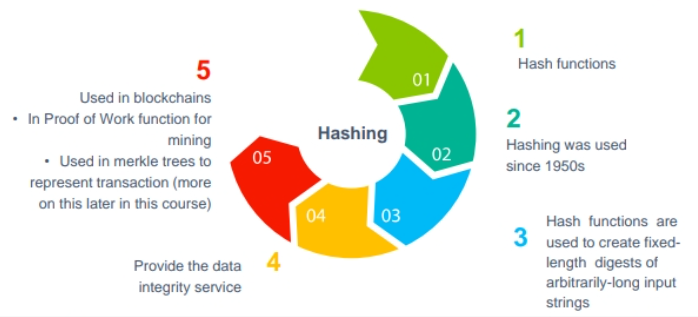
Hashing in Simple Terms:
Hashing is a process of taking an input message of any length and turning it into a fixed-length message digest. This is done using a hash function.
Hash Functions
Hash functions are used to create fixed-length digests from input messages of any length.
Hash functions are keyless and provide data integrity services. They are typically built using iterated hash function construction techniques and come in different varieties, such as MD, SHA-1, SHA-2, SHA-3, RIPEMD, and Whirlpool. Hash functions are commonly used for digital signatures and Message Authentication Codes (MACs).
Hash functions have three security properties - preimage resistance, second preimage resistance, and collision resistance.
Compression of Messages Hash functions compresses arbitrary messages into a fixed-length digest. This digest is usually 128-bit to 512-bits long.
Efficiency Hash functions are fast and efficient one-way functions. They are designed to be quick to compute even for large messages.
Security Properties
Preimage resistance: This means that given the hash output, it should be practically impossible to reverse-compute the input message.
Second preimage resistance: Given an input message and its hash, it should be almost impossible to find another message with the same hash.
Collision resistance: Two different input messages should not produce the same hash output.
Construction of Hash Functions Hash functions are typically constructed using iterated hash function construction techniques. One such technique is the Merkle-Damgard construction, where the input message is divided into equal-sized blocks and each block is fed through compression functions in an iterative manner. Compression functions can be built using block ciphers and ensure that the hash output is collision-resistant.
Decentralization
Have you ever heard of the concept of decentralization? It means spreading out control and authority, rather than having one central authority in charge. This idea has been around for a long time and has been used in various fields, including management and government.
And guess what? Decentralization is also a key aspect of blockchain technology! With blockchain, there's no need for a middleman or a trusted third party to validate transactions. Instead, a consensus mechanism is used to agree on the validity of transactions.
By decentralizing the control, blockchain technology brings several benefits, such as increased efficiency, faster decision-making, better motivation, and less strain on top management. This is just one of the ways blockchain is revolutionizing the way we do business.
Concept of Decentralization
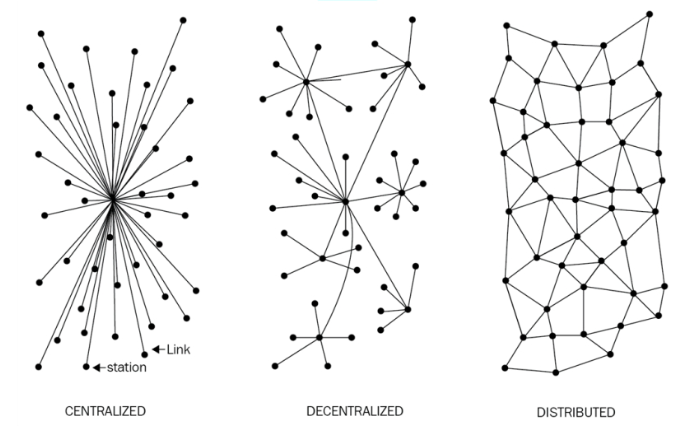
Decentralization is a key feature of blockchain technology. It means that the platform does not rely on intermediaries and can function with multiple leaders chosen through consensus mechanisms. This competition is governed by Proof of Work (PoW) and the level of decentralization can range from semi-decentralized to fully decentralized, depending on the situation. Decentralization, as seen through blockchain, provides a way to either modify existing systems or build new ones that give users full control. Traditionally, Information and Communication Technology (ICT) was based on a centralized model, where a single authority controlled the database or application servers. But with blockchain, anyone can start a decentralized system that operates without a single point of failure or trusted authority. The level of human involvement in the decentralized application running on blockchain depends on the type of governance used. The diagram shows the three main types of systems currently in existence: centralized, decentralized, and distributed. This concept was first introduced by Paul Baran in his 1964 publication, "On Distributed Communications: I. Introduction to Distributed Communications Networks".
Types of Networks/Systems
In simple terms, there are two main types of IT systems: centralized and decentralized. Centralized systems have one main authority that controls all operations and all users rely on this single source for service. Many popular online service providers, like Google, Amazon, eBay, Apple's App Store, and others, use this model. A distributed system is when data and computation is spread across multiple nodes in a network but still have a central governing authority.
A decentralized system, on the other hand, has no central authority, and control is shared among many nodes, like each department in an organization having control of its own database server. Decentralized systems were made possible by the innovation of decentralized consensus, which was first introduced through Bitcoin. This allows users to agree on something without the need for a central trusted third party.
The critical difference between a decentralized system and distributed system is that in a distributed system there still exists a central authority that governs the entire system; whereas, in a decentralized system, no such authority exists.
Blockchain for Decentralization
How to decentralize?
Evaluating the decentralization of blockchain technology has become easier with the framework proposed by Arvind Narayanan and others in their book "Bitcoin and Cryptocurrency Technologies". The framework raises four questions that can help understand how a system can be decentralized:
What system is being decentralized?
What level of decentralization is required?
Which blockchain is suitable for the specific application?
What security mechanism will be used to ensure the integrity of the system?
These questions help determine what system needs to be decentralized (identity system or trading system), what level of decentralization is required (full or partial), which blockchain is suitable for the specific application (Bitcoin, Ethereum, etc.), and how the security of the decentralized system will be ensured (using atomicity-based or reputation-based mechanism). This framework provides a clear understanding of decentralization and its requirements in the context of blockchain technology.
Decentralized Organizations
Decentralized Organizations (DO) are digital programs that operate on blockchain technology. They function like real organizations with rules and people but run on code instead of being controlled by a single entity. Once a DO is put into the blockchain through a smart contract, it becomes decentralized and parties interact with each other according to the rules coded in the DO software.
Decentralized Autonomous Organizations
A Decentralized Autonomous Organization (DAO) is a computer program that runs on a blockchain. It has rules for governing and running a business, which is built into the program itself. Unlike DAOs, a traditional organization (DO) relies on human input to make decisions. The Ethereum blockchain was the first to introduce DAOs. In a DAO, the code makes the decisions instead of people or paper contracts. But, a human curator is responsible for maintaining the code and evaluating proposals for the community. DAOs can even hire external contractors with enough input from participants. The most well-known DAO project is "The DAO," which raised $168 million in its initial funding phase. However, the project was hacked due to a code bug and millions of dollars were lost. This incident sparked a debate about the security and quality of code in smart contracts and the need for thorough testing. Currently, DAOs don't have any legal standing, but there are efforts underway, especially in academia, to formalize smart contract coding and testing. In the future, code commissioned by law enforcement or regulators, known as Autonomous Agents, could be embedded in a DAO to ensure its compliance and integrity from a legal perspective. DAOs are decentralized and can operate in any jurisdiction, raising questions about how current legal systems can be applied to them.
Decentralized Autonomous Corporations
DACs, or Decentralized Autonomous Corporations, are similar to DAOs (Decentralized Autonomous Organizations). They both run on a blockchain, but DACs are smaller and can make a profit by selling shares and paying dividends to participants. DACs can run a business automatically with the logic programmed into them, without human intervention.
Decentralized Autonomous Societies
Decentralized Autonomous Societies (DASs) are a vision of how entire communities can run on a blockchain using a mix of complex smart contracts, DAOs, and Decentralized Applications (DApps). This model is not about chaos or extreme freedom, but rather about using blockchain technology to deliver services that are typically provided by governments, such as identity cards, passports, and vital records like birth certificates, deeds, and marriages. The idea behind DASs is that, if traditional systems aren't trustworthy enough, communities can create their own virtual society on a blockchain that is powered by decentralized rules and transparent operations. This idea may sound like a radical notion, but it's actually achievable using blockchain technology.
Decentralized Applications (DApps)
DApps, or Decentralized Applications, are made up of different types of digital organizations like DAOs, DACs, and DOs. All of these are computer programs that work on a blockchain, which is a decentralized network. This means that instead of relying on a central authority, the power is spread out among many participants in the network.
DApps can run on their own blockchain, use an existing one, or just use the protocols of an existing blockchain. There are three types of DApps: Type I, Type II, and Type III. This new technology of decentralized organizations is a huge step forward in the world of digital decentralization.
History and Evolution of Blockchain
In 2008, a mysterious person using the pseudonym Satoshi Nakamoto wrote a groundbreaking paper about electronic cash in a peer-to-peer system. This paper introduced the concept of a "chain of blocks," which later became known as the blockchain. Satoshi was active in the Bitcoin community as a developer until 2011, when he suddenly disappeared without a trace. No one knows who Satoshi Nakamoto really is, and their identity remains a mystery to this day. Despite this, the ideas and technology introduced by Satoshi have continued to shape and evolve the world of cryptocurrency and blockchain.
Blockchain 2008 to Date
The blockchain industry has come a long way since its discovery in 2008. Today, we see a divide between the crypto-asset and ICO world, and the regulated business world that is led by banks and financial institutions. Both sides have leveraged the growth of blockchain to advance their own interests. On one hand, we've seen a rise in the value of Bitcoin and other crypto assets, and the emergence of ICOs, despite regulatory challenges. On the other hand, we've seen businesses focus on using blockchain for efficiency and cost savings, such as faster settlement and interbank transfers, and symmetric information dissemination in supply chains.
The focus for businesses has been on understanding the technology and reimagining their ecosystems, networks, and business models. They are working towards symmetrical information dissemination and improved business processes. However, most businesses are still focused on their current operations and regulatory compliance, and they face challenges with blockchain technology, such as confidentiality and privacy.
Despite these challenges, businesses are starting to recognize the importance of blockchain-driven ecosystems and networks. The technology is here to stay and will continue to mature and deliver on its promise of efficiency and efficacy. The innovation agenda has been re-energized and is attracting top talent to work on industry and technology challenges. The future of business success will likely depend on blockchain technology and the ecosystems and networks it drives.
Byzantine Generals' Problem
In 1982, a group of researchers wrote a paper called "The Byzantine Generals' Problem," which describes a situation where a group of army generals are trying to coordinate an attack on a city. The only way they can communicate is through a messenger, but there's a problem: one or more of the generals might be traitors who could send false messages. To solve this problem, the researchers proposed a solution where the generals could still agree on the attack plan even if there were treacherous generals involved.
To understand the problem better, imagine the generals as nodes in a network, the traitors as malicious nodes, and the messenger as the communication channel between the nodes. In 1999, two researchers, Castro and Liskov, found a solution to this problem by creating the Practical Byzantine Fault Tolerance (PBFT) algorithm, which ensures that all nodes reach a consensus on the attack plan after a certain number of messages with the same information have been received.
In a distributed system, a node is an individual player that can send and receive messages to and from other nodes. Nodes can be honest, faulty, or malicious, and they have memory and processing capabilities. If a node acts irrationally, it's known as a Byzantine node, named after the Byzantine Generals' Problem.
Consensus Algorithms
Consensus: Consensus is the foundation of a blockchain. It gives decentralization of control through a process called mining. Not all consensus methods are good for every type of blockchain. For example, public permissionless blockchains need to use a more secure method like Proof of Work (PoW) instead of a simple agreement method based on proof of authority. It's important to choose the right consensus method for a blockchain project.
Consensus is an agreement between nodes in a blockchain network on the final state of the data. To reach a consensus, different algorithms are used. It's easy to reach an agreement between two nodes, but it becomes challenging when multiple nodes are involved and need to agree on a single value. This process of reaching a common state or value among nodes despite some failures is called distributed consensus.
Consensus Mechanism: A consensus mechanism is a series of steps taken by most or all nodes in a blockchain network to agree on a proposed state or value. This concept has been researched by computer scientists for over 30 years and has gained popularity with the rise of blockchain and Bitcoin. There are different requirements that must be met to make a consensus mechanism effective, including agreement among all honest nodes, termination of the consensus process, the validity of the agreed-upon value, ability to run in the presence of faulty nodes, and integrity (no node can make a decision more than once in a single consensus cycle).
Consensus in Blockchain: Consensus is a concept used in blockchain technology to make sure all peers on the network agree on a single version of the truth. This concept was covered in the previous section on distributed systems. In this section, we will talk about consensus in the context of blockchain technology. Although the concepts are still relevant to distributed systems theory, they are explained from a blockchain perspective.
Blind Signatures
Blind signatures are a type of digital signature that helps protect the content of a message by disguising it before it's signed. This is an important tool used in the design and implementation of blockchain systems.
The Heart of Blockchain: Consensus Consensus is crucial in blockchain technology as it provides a means of guaranteeing that the data stored in the blockchain is accurate. This is achieved by having multiple players in the network that bring capital or computing power. The goal is to create a shared data store with the same level of security as enterprise data, but with a lower barrier to entry.
Cryptography and Blockchain Cryptography is also a key aspect of blockchain as it provides authentication and verifiable transactions. The focus of cryptography in the blockchain is to make it difficult for any adversarial processes to break the system. In a bitcoin blockchain, the cryptographic considerations are different than in a less democratic or permissioned ledger network.
Safeguarding Consensus The ultimate goal is to create a secure and economically viable blockchain network that is trusted by its users. Blind signatures, multi-signatures, and zero-knowledge proofs (ZKP) are all tools that can be used to achieve this. However, it's important to note that no single technology can guarantee the security of a blockchain network.
Proof of Work
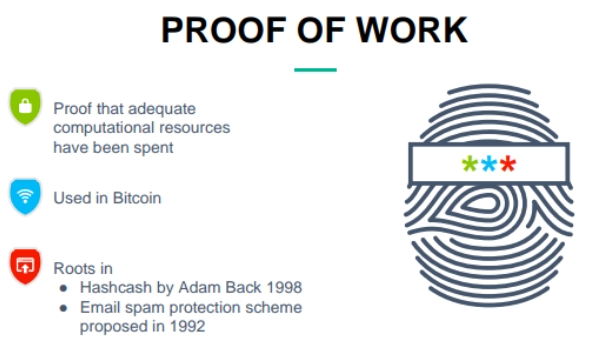
Proof of Work is a type of consensus mechanism in which a user needs to prove that they have spent enough computational resources to propose a value. This type of algorithm is used in Bitcoin, Litecoin, and other cryptocurrencies. It's the only algorithm that has been successful against potential attacks like the Sybil attack.
Sybil Attack: A Sybil attack occurs when an attacker tries to control the network by filling it with fake clients. This could lead to a situation where you would only connect with nodes controlled by the attacker.
Proof of Stake

PoS works by considering a user's investment in the system as a stake and any malicious attempt would not be worth the cost. It was first introduced by Peercoin and is used in Ethereum's Serenity version. The chances of proposing and signing the next block depend on the amount of time and number of coins that have not been spent, called coin age.
Delegated Proof of Stake (DPoS): DPoS is an improvement over PoS, where nodes with a stake in the system can delegate validation to other nodes by voting. It is used in the BitShares blockchain.
Proof of Elapsed Time (PoET): PoET uses a Trusted Execution Environment (TEE) to provide randomness and safety in the leader election process through a guaranteed wait time. It requires Intel's SGX processor for security.
Proof of Deposit (PoD): In PoD, nodes have to make a security deposit to participate in the network and mine and propose blocks. This is used in the Tendermint blockchain.
Proof of Importance (PoI): PoI considers not only a user's stake in the system but also their token usage and movement to establish a level of trust and importance. It is used in the NEM coin blockchain.
Federated Consensus: In this mechanism, nodes retain a group of trusted peers and only propagate transactions that have been validated by the majority. It is used in the Stellar consensus protocol.
Reputation-based mechanisms: A leader is elected based on their reputation on the network, determined by votes from other members.
Distributed Ledger Technology
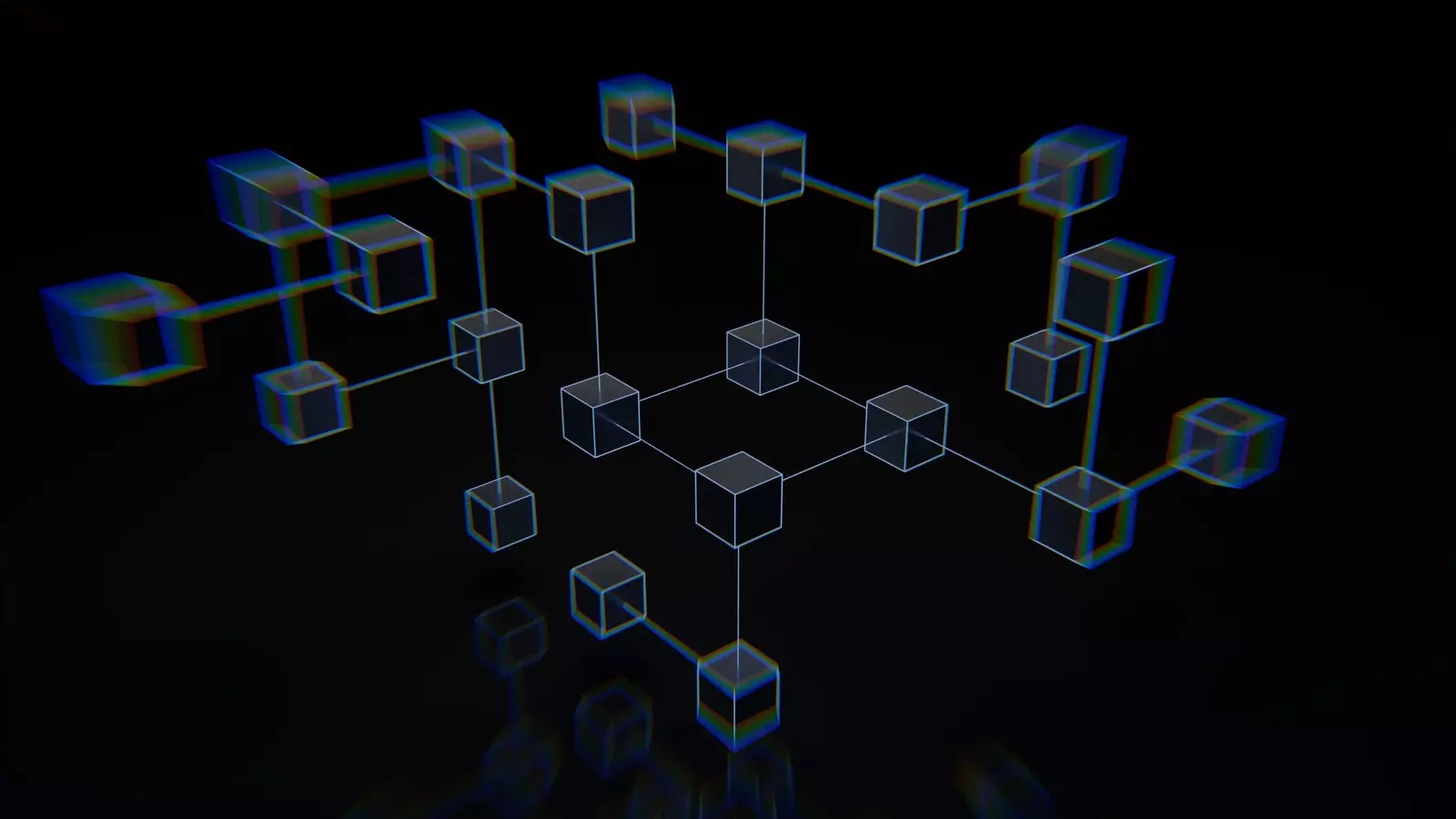
A distributed ledger is a shared database, but not all shared databases are blockchains. Blockchains are a type of distributed ledger that use blocks of transactions to maintain the database, such as Bitcoin and Ethereum. On the other hand, some distributed ledgers don't use blocks, such as R3's Corda which is designed for financial services.
DLT, or Distributed Ledger Technology, is a term that's evolved to describe blockchain in the finance industry. It's used interchangeably with blockchain, but DLT refers to permissioned blockchains that are used by known participants. These ledgers serve as a shared database without the need for mining or a cryptocurrency. DLT is a growing area of research in finance.
Blockchain Classification
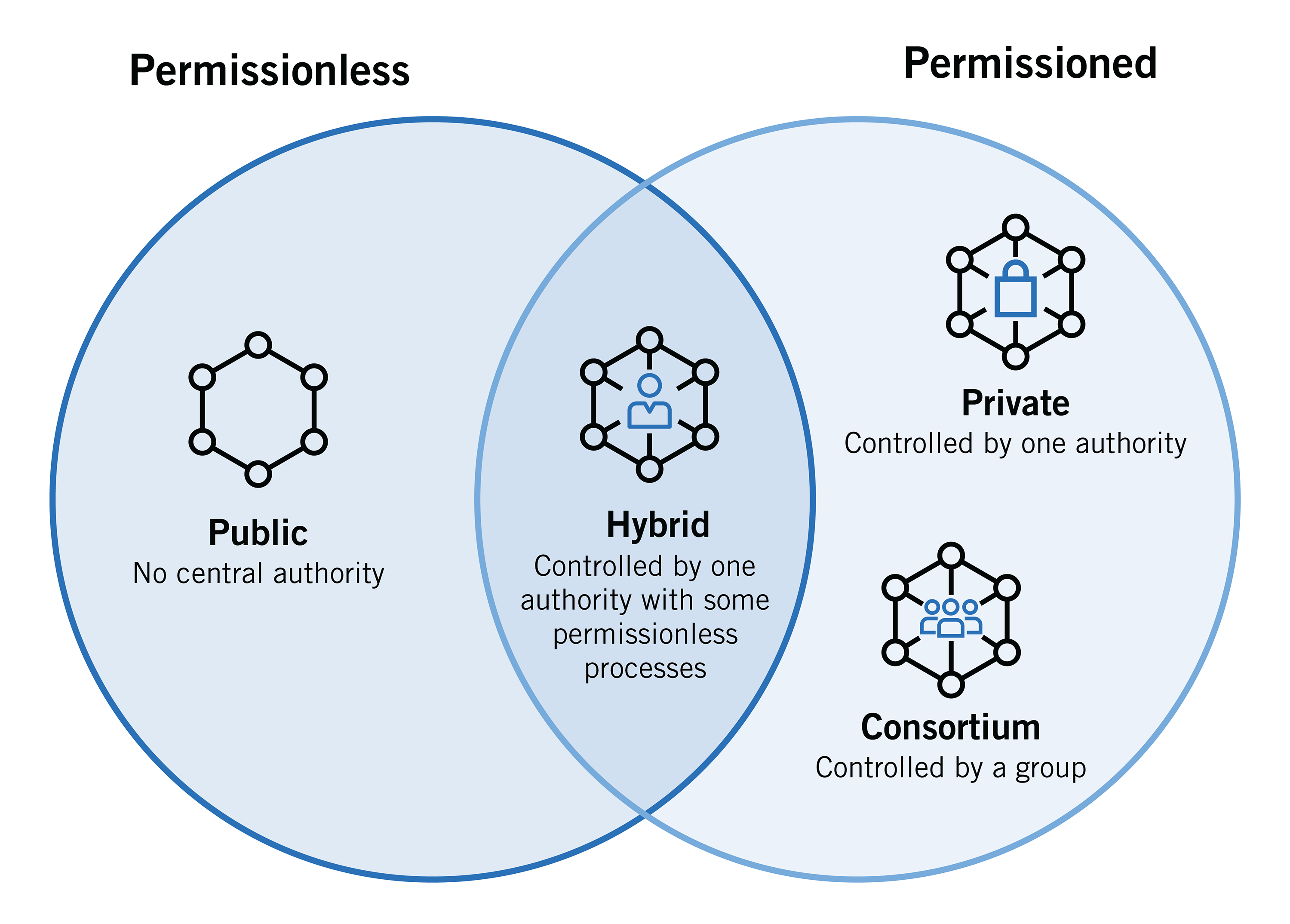
Public Blockchains: Open to the public and anyone can participate as a node. They use a distributed consensus mechanism to maintain a copy of the ledger. Examples: Bitcoin and Ethereum.
Private Blockchains: Only accessible to a consortium or group of individuals. Can run in public mode but is primarily used for private transactions. Examples: HydraChain, Quorum.
Sidechains: A way to move coins from one blockchain to another and back again. Uses Proof of Burn (PoB) as an alternative method for distributed consensus. Examples: Rootstock and Stacks (enables smart contract development for Bitcoin).
Permissioned Ledger: Participants are already known and trusted. Uses an agreement protocol instead of distributed consensus. Can be public with regulated access control. Example: Bitcoin with access control layer.
Shared Ledger: A database shared by the public or consortium. All blockchains fall into this category.
Tokenized Blockchains: Standard blockchains that generate cryptocurrency via mining or initial distribution. Examples: Bitcoin, Ethereum.
Tokenless Blockchains: Designed for data sharing among trusted parties, not for value transfer or cryptocurrency. Similar to full private blockchains. Benefits: immutability, security, consensus-driven updates.
How Blockchain Works
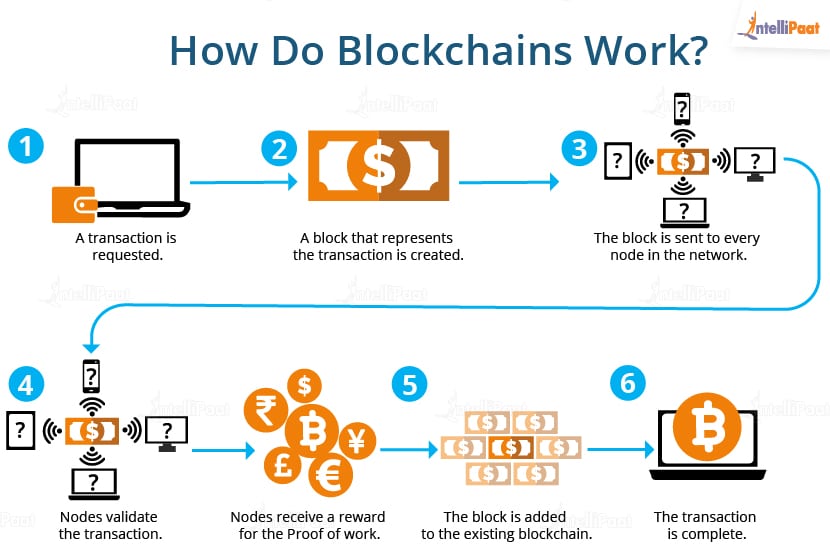
Blockchain accumulates blocks through the following process:
A node initiates a transaction by creating and signing it with its private key. Transactions represent various actions and commonly represent the transfer of value between users.
The transaction is then validated through a Gossip protocol by multiple peers before being included in a block.
The newly created block becomes part of the ledger and links to the previous block through a hash pointer.
Transactions are reconfirmed each time a new block is created, with six confirmations being the standard for considering a transaction final in the Bitcoin network. Note that while steps 4 and 5 are not compulsory, they provide added security for the transaction.
Applications of Blockchain
Blockchain has numerous applications in various industries, including finance, healthcare, media, arts, law, fashion, culture, and government.
Insurance: By using blockchain, the process of filing and paying insurance claims can become automated, secure, and cost-effective. For example, if a flight is canceled, the smart contract could automatically trigger payment to the traveler. This eliminates the need for a manual claim process and provides a trustworthy system.
Health: Blockchain technology offers benefits in the health industry, such as better privacy, fewer data breaches, lower costs, and reduced fraud. It also helps in preventing counterfeit medicines and improving the overall efficiency of healthcare operations.
Media: Blockchain can resolve the critical issues of content distribution, rights management, and royalty payments in the media industry. For instance, it can provide a secure network for digital music ownership and royalty payments controlled by smart contracts. This eliminates the need for a centralized media authority and ensures that payments are made automatically and transparently.
Overall, blockchain technology provides immutability, transparency, and cost-effectiveness that traditional systems cannot match. The use of smart contracts allows for flexibility and automation in real-world scenarios, providing a trustworthy solution for various industries.
Challenges in Blockchain Adoption
Scalability: Scalability is a crucial challenge in blockchain adoption, as it determines whether blockchain will be widely adopted or limited to private use only. Solutions have been proposed, but the topic requires further exploration.
Privacy: Privacy is a highly sought-after property in blockchain, but due to its transparent nature, it may not be suitable for industries that require privacy, such as finance and healthcare. There are various proposals for addressing privacy concerns, including Indistinguishability Obfuscation (IO), homomorphic encryption, ZKPs, and ring signatures.
Future Scope of Blockchain Technology
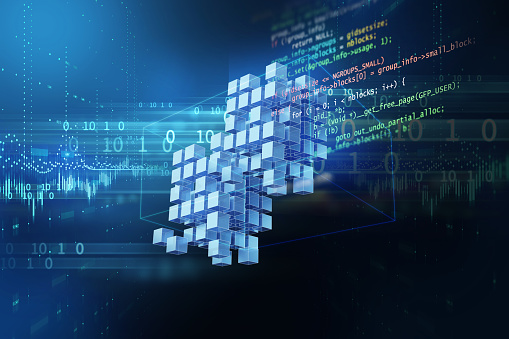
Blockchain technology has a far-reaching impact on various industries such as finance, government, media, and many others. With the integration of blockchain with other cutting-edge technologies like AI, machine learning, and IoT, the potential of this technology is even more immense. This convergence will lead to the emergence of new use cases, driving wider adoption of blockchain.
It is projected that blockchain will become a ubiquitous part of our daily lives, just like a common search engine or the internet. People will perform their daily activities using blockchain technology without even realizing it.
As per various market research and experts, the maturity of blockchain technology is estimated to be around 2025. With the increasing demand for secure, transparent, and efficient systems, the growth of this technology is inevitable. In the coming years, we can expect blockchain to play a critical role in shaping the future of various industries and our daily lives.
Subscribe to my newsletter
Read articles from Ali Raza directly inside your inbox. Subscribe to the newsletter, and don't miss out.
Written by

Ali Raza
Ali Raza
Visionary Technologist, Strategic Builder, Creative Problem Solver, Technical Expert, Consultant and a Relationship-Focused Collaborator. Active in aiding blockchain startups.